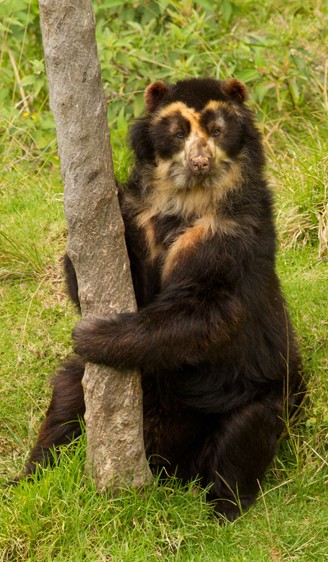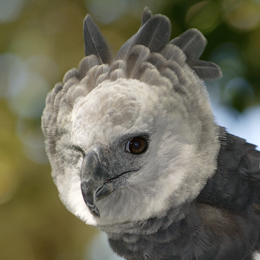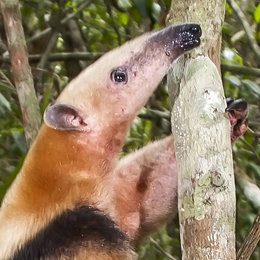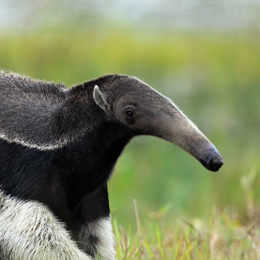Description
The Spectacled bear or the Andean Bear is only found in the cloud forests of The Andes located in Northern and Western South America.
It is also called the Andean short-faced bear, due to its shorter snout. All other species of the short-faced bears are now extinct; leaving spectacled bear as the lone survivor of its community.
The elusive bear is known as the “jukumari” in the local Aymara community, while, in Quechua language, it is called the “ukumari”.
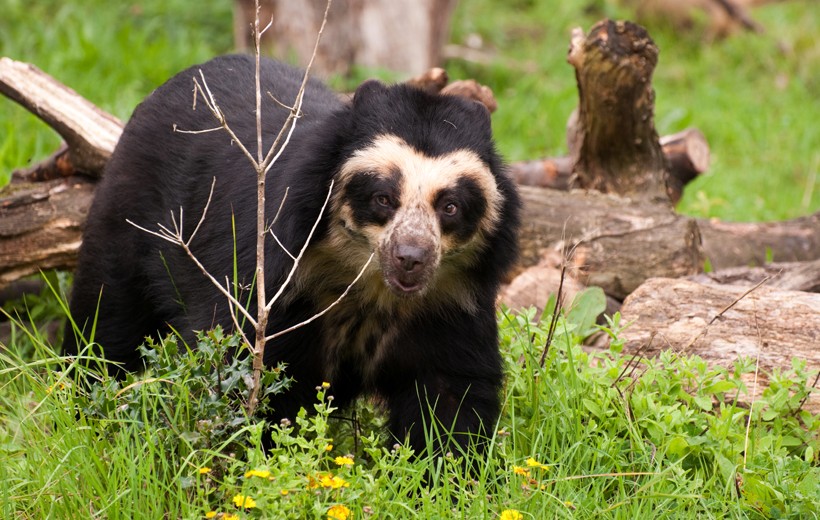
Spectacled bear wearing 'spectacles'
?
Image credits: Chris Humphries/Shutterstock
The name “spectacled”, given to the bear, is widely embraced due to the creamy-white colored line of fur encircling its eyes. The Spectacled bear is completely black in color, with light colored patches of fur on its chest and around the eyes.
The light colored fur doesn’t always encircle the eyes completely, but when it does, it looks like the bear is wearing spectacles. Every bear has a different pattern of these light colored patches on their body. Biologists use this distinctive feature to recognise individual bears for study.
Males and females of the species can be easily distinguished by their difference in size.
Due to their extremely shy and elusive nature, they are very difficult to spot in the lush cloud forests of The Andes; which is why very less is known about the spectacled bears’ lifestyle in the wild.
To fill in the blanks, researchers also keep a track on behavior, health and lifestyle of the bears in captivity. The female is smaller and weighs a third less as compared to the male spectacled bear. A healthy adult male can weight up to 160 kg while the female weighs between 80 to 90 kg.
There is no data on the bear’s maximum age in the wild, but healthy bears in captivity live for up to 25 years. An adult can be up to 6 feet in length.
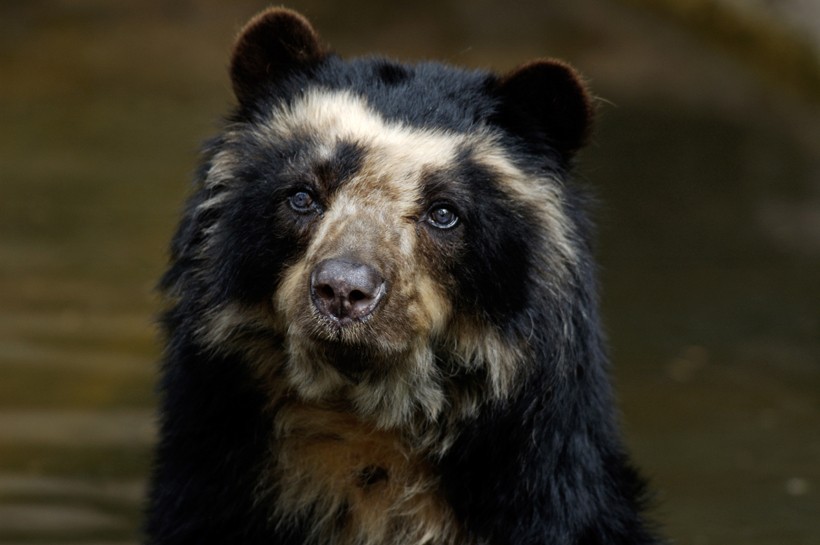
Spectacled bears have a sufficient sense of vision
?
Image credits: Bildagentur Zoonar GmbH/Shutterstock
Spectacled bears have sufficient sense of hearing and vision. In cloud forests, the dense cloudy atmosphere, thick vegetation and rich wildlife, make it extremely difficult for an animal to see clearly or hear precisely.
Being the largest carnivores in South America, the spectacled bears also have no need to keep an eye out for predators. Under such circumstances, the most effective sense in the Andes is the sense of smell and the bear knows that well.
They depend majorly on their nose, which can pick up the smell of ripe fruits or dead carcasses from several miles away. Spectacled bears are known to travel large distances in search of food in its habitat.
Habitat
The spectacled bear population is distributed only along the Andes mountain range located in the Northern and Western South America. These bears prefer a wet habitat with high levels of humidity in the air. They are usually found at an elevation above 1900 meters in the mountains, where there are dense vegetation and plenty of food sources available for the bear. However, these animals are highly adaptable and can survive in different conditions depending on the availability of food.
They have been found at altitudes as low as 250 meters and as high as 5000 meters. These wet forests are very rich in wildlife and vegetation, with lush trees and bushes covering the entire mountain grounds.
The climate remains constant throughout the year in these equatorial cloud forests. As there is no winter, spectacled bears do not hibernate. Unlike other bears that spend cold times in hibernation, the spectacled bear can be seen active throughout the year due to its habitat.
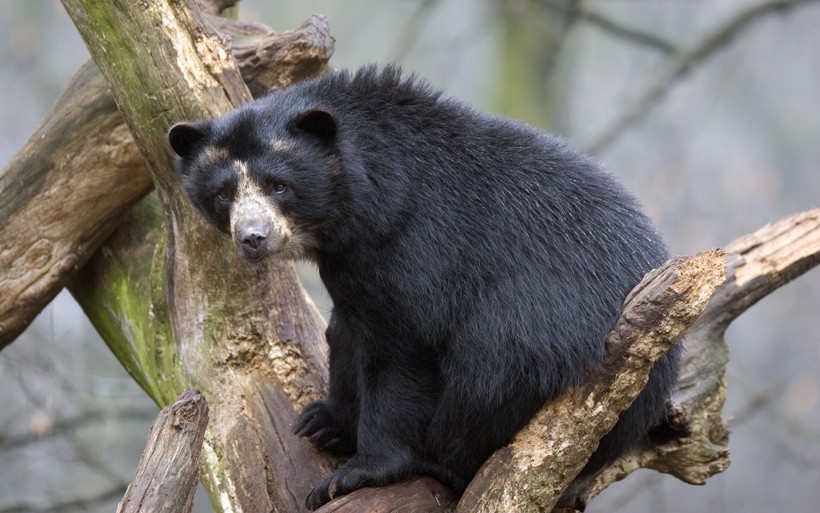
Spectacled bears are known to make beds on top of trees to relax.
?
Image credits: Bildagentur Zoonar GmbH/Shutterstock
The spectacled bear spends most of its life on trees and loves to feed on fruits, berries, orchid bulbs, roots, tree bark and bamboo.
They cover vast areas inside the dense forests in search of food and feed on a wide range of plants.
Early researchers considered this species as vegetarian until recently, when biologists observed that they occasionally hunt and scavenge for meat as well. The bear feeds on beetles, termites, dead cows, rodents and other small mammals, for meat.
Cattle killings in the region were often linked to the more notorious mountain lion, which shares its habitat with the spectacled bear in The Andes. Recently, when biologists got a hand on a cow that escaped an attack from a predator, they were able to closely study the inflicted wounds for the first time. A closer look was enough to clear the mist. Cats like leopards and mountain lions, inflict a damaging bite on the throat of their prey to suffocate the animal to death. Unlike the wild cats, bears bite the backbone of their prey to immobilise it.
When they found a deep wound on the back of the cow, but nothing on its throat, it was clear that it was a bear attack; and the only bear in South America is the spectacled one.
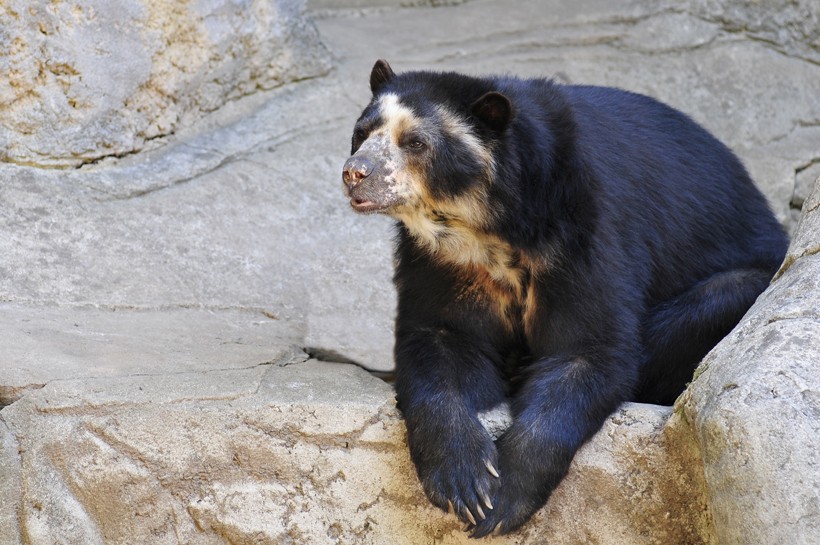
They have been found at altitudes as high as 5000 metres
?
Image credits: Christian Musat/Shutterstock
Spectacled bear hunts very rarely. Only 5% of the spectacled bear diet consists of meat while the rest is composed entirely of vegetation.
Due to a wide range of options, the spectacled bear faces little to no competition for food. However, they are highly affected by the human establishment and deforestation in The Andes.
As human population increases in the spectacled bear habitat, the bears are pushed to higher altitudes. Overgrazing and deforestation inflict huge losses to the bear as they lose their resting sites and feeding grounds.
Biologists point at this factor as one of the primary reasons for the few cattle killings in the region. Otherwise, the spectacled bear is a calm and shy bear that loves to eat fruits and berries of the forest.
Reproduction and life cycle
Female spectacled bears reach sexual maturity between the age of 4 and 7 years while for males the age of sexual maturity is 3 to 5 years.
Males search for females in oestrus and mate with them. Very little is known about their mating behavior in the wild.
Biologists have recorded increased vocalisations and sightings of mating pairs between the months of March and October.
Females give birth to 1 to 2 cubs between December and February, when there are heavy rainfalls and plenty of available food sources. Based on this information the gestation period is speculated to be anywhere between 200 to 240 days (in captivity there are records of a gestation period between 5,5 and 8,5 months).
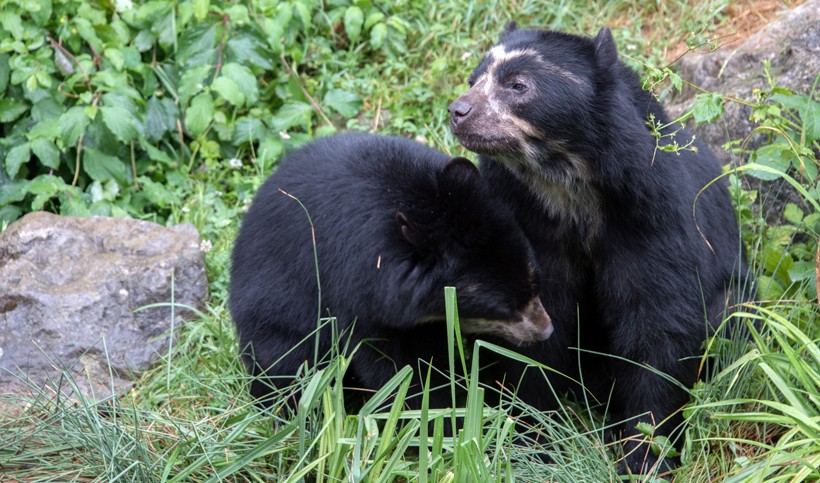
The cubs don’t leave the mother until they are more than 3 years in age.
?
Image credits: Andrea Izzotti/Shutterstock
The females give birth to one or two cubs weighing approximately 300 grams. For the first three months, the female takes intensive care of the cubs.
In captivity, the cubs are seen eating solid foods only after they are 85-90 days old.
The spectacled bear cub is born blind. The eyes don’t open until they are 25-40 days old.
Bear cubs grow very quickly at the starting stages after birth. The spectacled bear cub can grow from 300 grams to 10 kg in 6 months time.
The cub is fed by its mother’s milk for the first 3 months only. After approximately 3 months, the mother introduces the cubs to the outside world by taking them aside her, in search of food.
The female sometimes travels large distances in search for food and the baby climbs on her back whenever it’s tired. The cub learns its ways by imitating its mother and playing with her.
The cubs don’t leave the mother until they are more than 3 years in age. Male cubs leave their mother just before reaching sexual maturity. This way, the males can mate in the immediate next season and sustain their population.
Under the safety of an adult female, the spectacled bear cub faces no danger in the wild. They simply stick close to the mother to evade predators.
Being on top of the Andean food chain, the only danger faced by the spectacled bear cubs are humans. Especially when they have cubs, females are on the look-out for an easy meal. As a result, they often raid cornfields and other farms under human occupation.
When confronted by humans, the cubs are often orphaned and captured, made pets, or raised in inappropriate conditions.
Behavior and Communication
Spectacled bears are solitary and arboreal in nature. Adults are seen together only during the mating season. They are efficient tree climbers and spend most of the time up in the trees of the Andean cloud forest, which makes them extremely hard to find for biologists and researchers.
The bear seems to have precise knowledge about different edible plants in its territory. Most of its day is spent in looking for food.
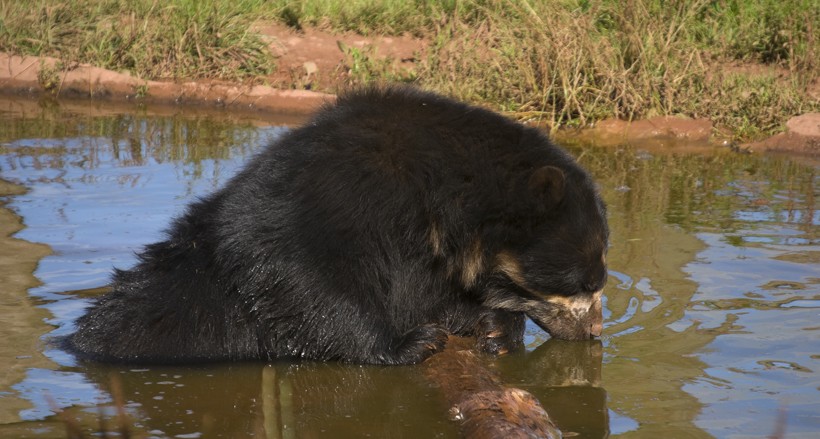
Spectacled bear drinking water
?
Image credits: Stephen Meese/Shutterstock
They are extremely shy and calm in nature. Due to their shy and elusive behavior, researchers once assumed that the bear must be completely nocturnal. Detailed studies revealed later, that the spectacled bear is completely diurnal, with minimal to no activity at night.
They are known to scavenge for carcass meat. Mountain lions are active hunters in Andean forests. But, the scavenging spectacled bear is often blamed for being the killer as it is often spotted feeding on the carcass.
Behaviorally, the spectacled bear is very similar to the giant pandas of China. Like pandas, they love to eat bamboo and tend to spend a calm lifestyle.
They are solitary, but not very territorial. Individuals can be seen feeding together without any conflicts.
Females care for their cub for as long as 3 years. Due to this behavior, it is suspected that minimal level of intercommunication is possible between spectacled bears.
Vocalisations during the mating seasons are also pointed out by researchers as evidence of communication.
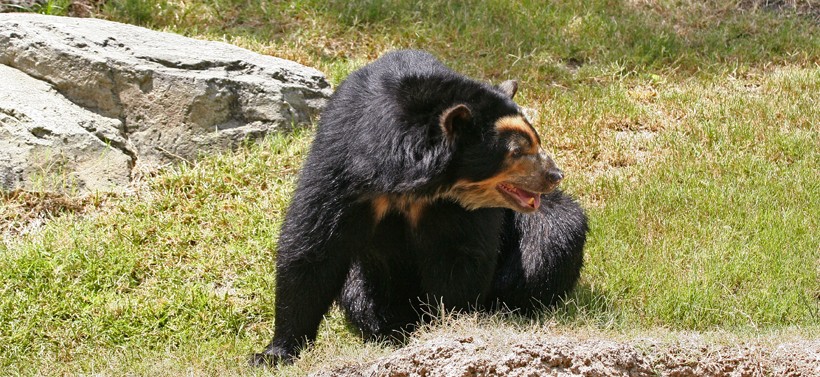
Spectacled bears are extremely shy and calm in nature.
?
Image credits: 1552299/Shutterstock
In its habitat, the spectacled bear can be seen using different ways to find its food. Long-term observations proved that the bear somehow manages to understand when and where its favourite food can be available.
They are also known to make beds on top of trees to relax. They break nearby branches and make a giant nest on top of the tree whenever they need a nap. They also wait for fruits to ripen before they eat it.
Due to such understanding of its surroundings, it is speculated that the spectacled bear is a very intelligent creature, with good problem-solving abilities.
Evolution
Spectacled bears and all other bears of the modern world fall under the family Ursidae of the suborder Caniformia. All these carnivorous animals share a common characteristic, which is the “dog-like” snout.
The Parictis and Allocyon are the earliest members of the Ursidae that roamed on earth approximately 38 to 18 million years ago. These were small predators, with a major part of their diet consisting of small insects. These ancient bears were not larger than the modern raccoon.
Approximately 13 million years ago, the short-faced bears differentiated from the Ursidae. They were named scientifically as the Tremarctinae.
The earliest known short-faced bear is the Plionarctos. It evolved around 10 million years ago and later changed into different species of short-faced bears, including the giant short-faced bear that could weight up to 1000 kg.
The modern Andean spectacled bear is the only surviving species of the short-faced diversion of bears. However, they are also under extreme threat of extinction.
Population and Conservation Status
The entire spectacled bear population is distributed along the forests in Western Bolivia, Northwestern Argentina, Venezuela, Ecuador, Columbia and Peru. Some have also migrated towards the forests in Panama.
There are less than 3000 of them left in the wild and are under the threat of extinction. Human population and occupation are the primary factors for this bear’s vulnerable state of existence.
The local population has occupied large portions of the remote areas by clearing off the dense vegetation of the cloud forest.
The dense trees are now replaced by fields and, therefore, the bears are pushed deeper into the cloud forests. A vast portion is also lost due to cattle grazing, as a result of which, the bears experience a lack of food sources.
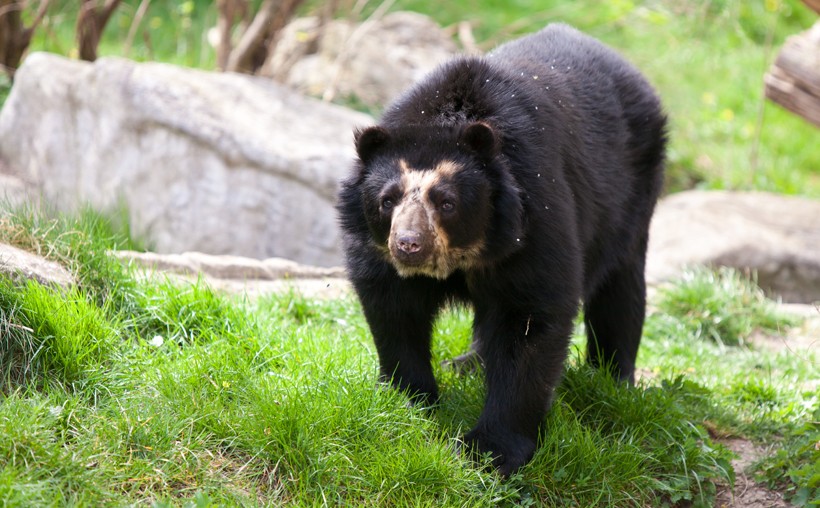
Spectacled bears are under serious threat of extinction.
?
Image credits: Andrei Preda/Shutterstock
The intelligent animal is highly adaptable and finds new sources of food when there is scarcity. In search of food, they often raid the farms or attack the cattle. This has resulted into hatred for the bear amongst the local farmers.
Humans shoot the adult bear in order to keep their fields and cattle safe while the bears face a loss of habitat and food.
Conservation measures are being taken widely to protect the beautiful and unique animal, but its elusiveness makes it very difficult for the researchers. Conservationists also carry out regular campaigns to educate the locals about the spectacled bear.
In some parts of its range, the locals are happy to see the amazing creature around them. But in other locations, they are seen with hatred.
Biologists speculate that the species can go extinct in the near future when effective methods of coexistence between human and bear aren’t applied quickly.
The spectacled bears can be kept safe by reducing human confrontations and increasing awareness about the harmless and calm nature of these gentle beasts.
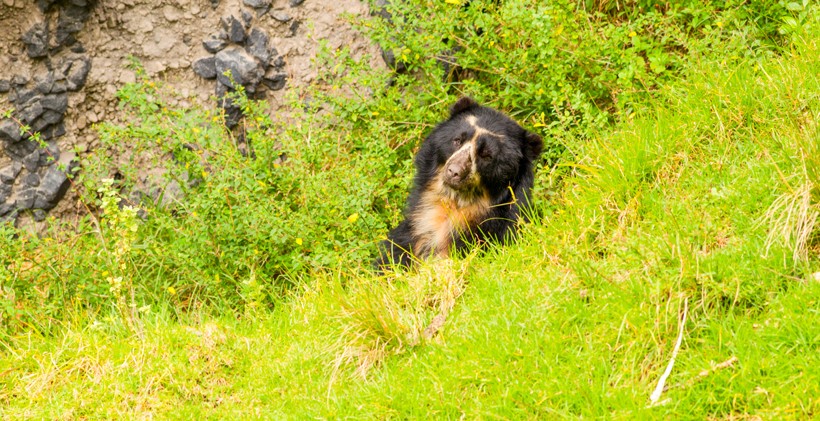
Extinction of the spectacled bear can destroy the entire ecology of Andes
?
Image credits: Ammit Jack/Shutterstock
Note The spectacled bear population in The Andes is under great threat and the situation can adversely affect the entire eco-system of The Andes.
The habitat is full of dense vegetation and cloud forests. The spectacled bears constantly chew on tree bark causing the trees to fall off early. As a result, open patches occur amidst dense vegetation and allow sunlight to the inner part of the forests.
As the inner ground receives sunlight, young plants get an opportunity to grow and the cycle continues.
Extinction of an animal so important can destroy the entire ecology of The Andes, which in turn will only affect the humans.
Funfacts
- They are called spectacled because of their white patch around the eyes.
- Their close relative, the giant short-faced bear was the largest species of bear to ever roam on the surface of earth. It could weight close to a ton and was 10-11 feet tall on its hind legs.
- The spectacled bear is the only South American bear known in the modern world.
- The famous stories of the Paddington bear written in 1958, was inspired by the spectacled bear found in South America.
- Writer Michael Bond wanted Paddington to be a bear from the darkest of Africa. This was later changed to South America when he realised that there are no bears in Africa.
- Spectacled bear is the last surviving short-faced bear species. The short-faced bears ruled the earth as lately 10,000 years ago.
